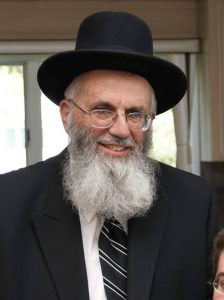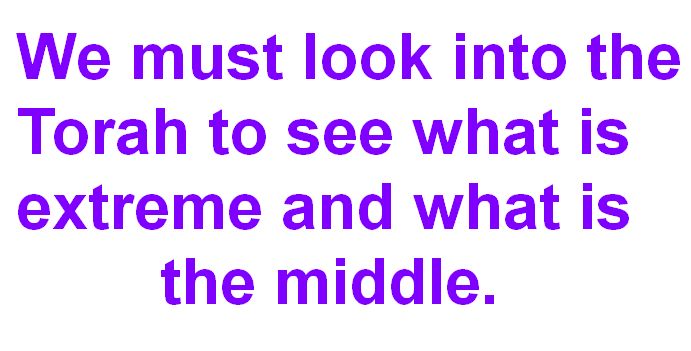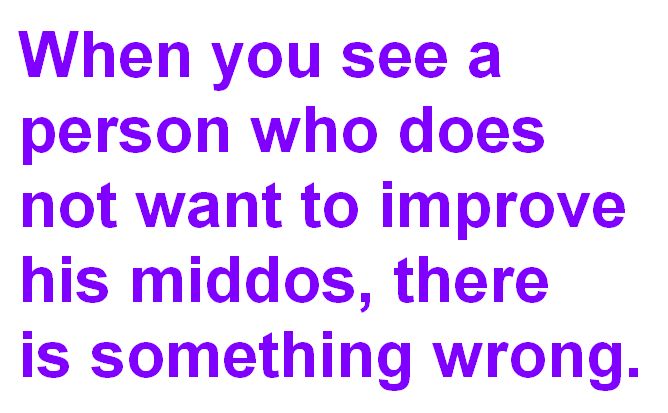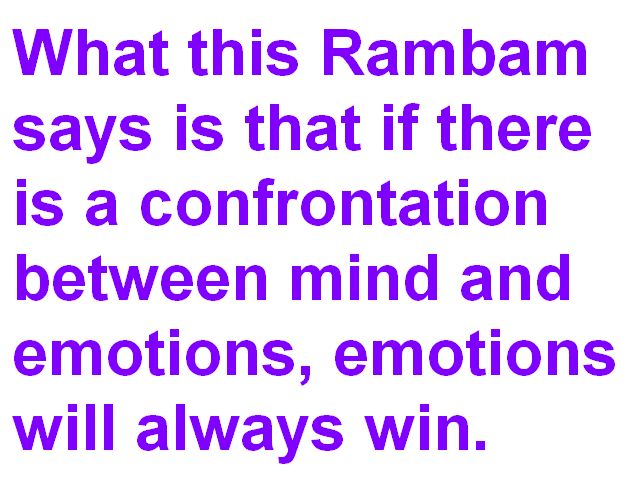| | NEWS
A Life's Work: Improving Our Middos
by HaRav Gershon Weiss zt"l

Part II
Improving ourselves is a task that is always in season, but it is especially appropriate as a preparation for kabolas haTorah. This essay and several more that will, iy'H, follow in the coming weeks, explains the basis for our obligation to work on improving our character, and the framework in which we should do so. One of the most important lessons is that we must turn to the Torah for guidance in middos — as in everything else in life. The following is based on tapes of shmuessen that were delivered at the Yeshiva of Staten Island. It was originally published in 1996.
The first part discussed the loss of the talmidim of Rabbi Akiva during Sefiras HaOmer because of their flaw in middos. We see that we must have good middos because we are commanded to emulate Hashem, the source of good middos is Sinai, and only from Sinai do we know the proper balance of middos.
The Middle of the Road
Rav Chaim Vital asks: Why isn't there a specific mitzvah in the Torah for middos?
My rebbe, HaRav Dovid Kronglas, zt'l, wrote in his Kuntrus (quoting Rav Chaim Vital): If there would be a mitzvah for each midda, a person would not know the limit of each midda. We learn the limit from veholachta bedrochov — that we should have the same middos as Hashem.
Many middos have two extremes. There will be one person who will give away everything and one who will give away nothing. Both extremes are wrong. A person must go in the darchei Hashem which is the derech beinonis. The middle road is the derech Hashem.
Someone once told the Brisker Rav that he had a proof that you have to join the Mizrachi party. He argued that on the left there was Mapai and Mapam, and on the right there is Aguda and Neturei Karta. Since Mizrachi, he said, is in the middle, and the Rambam said that one should go in the middle path, that is proof that one should join the Mizrachi party.
The Brisker Rav answered him: Who told you that the Aguda and Neturei Karta are on the right, the extreme? Maybe they are the middle ones?

We must look into the Torah to see what is extreme and what is the middle. How do we know what are extremes, and what is the middle? Veholachta bedrochov — what we see from Hashem and from the Torah is the only thing that can tell us what is the middle road.
The Rambam calls middos, dei'os. A person must use his da'as and learn the halochos. One of the ikarei ikarim in middos has to do with one's da'as, learning about them. We think middos have to do with emotions and with the heart. This is not completely true. We must work on middos through our da'as, through learning about them.
Whatever we see by the Ovos is the derech beinonis. Avrohom's chesed was not extreme. His hachnosas orchim too was the middle way. The way Yaakov worked for Lavan was also derech haemtzo'i. The gemorain Bava Metzia says that the way Yaakov worked for Lavan is the way every worker must work for his boss.
We see that Hashem has patience. Hashem gives food, shelter and parnossa to people even when they do not deserve it. Tomar Devorah says that all the 13 middos of Hashem are the way we have to follow. He analyzes the ways that Hashem is rachum and chanun for us to emulate.
The Benefit of Good Middos: Knowing Hashem
The Novi says: "...haskeil veyodo'a osi, ki ani Hashem oseh chesed utzedakah..." The highest goal of a person is to come to yedi'as Hashem. The Rambam says in the introduction to his Moreh Nevuchim: the Ribono Shel Olam wants a person to be like Him according to one's ability. His ways should be similar to Hashem. If a person tries to be like Hashem, it clears the way for yedi'as Hashem. Veholachta bedrochov brings to yedi'as Hashem.
The Rambam says that middos are the eyes of a person to see and know the Ribono Shel Olam. If one is self-centered or a baal ga'avah it is difficult to see Hashem since He is the exact opposite of this. In the writings of the early Greeks they wrote that their gods were jealous and were fighting. What these writers saw in their own nefesh is what they projected to their gods.
In order to see HaKodosh Boruch Hu, a person must have the right "eyes" and these are middos tovos. The talmidim of Rabbi Akiva had a chisaron in their middos, even a small one, they did not come to yedi'as Hashem.
My rebbe in his kuntrus quotes Rav Chaim Vital further: Middos are imbedded in the nefesh habehami which is close to the guf. There is no mitzvah for middos because middos must come before the Torah. The middos must be in a person before he starts learning Torah. If he does not have middos tovos, a person is not even a mentsch. The mitzvos are for the higher parts, for the neshomoh.
The Rambam in Hilchos Teshuva says that a person must do more teshuva for bad middos than for other things. My rebbe said that the Torah hakedosha brings a person to deveikus baHashem, but if a person's middos are the opposite of Hashem, then it is impossible to come to deveikus baHashem.
The Mishnas Rav Aharon asks: Why does it say "derech eretz kodma LaTorah?" Why is derech eretz before Torah? He answers: "HaTorah nitno lo'odom acharei sheyagi'ah lishleimus ha'enoshis binogei'ah lemiddos" — the Torah was given to a person only after he reaches shleimus in his middos.
During the 49 days between yetzias Mitzrayim and kabolas haTorah we had to work on our middos, in order to be able to receive the Torah. If a person doesn't have derech eretz it is impossible for him to become great in Torah.

Rav Chaim Vital says there are two levels. The first one is tzelem Elokim, which even the goyim have. The second is "bonim atem laHashem," which is unique to Bnei Yisroel. Still, one is dependent on the other. You need have the tzelem Elokim before you can become bonim atem laHashem.
The foundation is the important part. The foundation here is the "tzelem Elokim" which are our middos. As the Tomar Devorah says, the "tzelem Elokim" is the highest aspect of middos, to be like Hashem.
What is the difference between "veholachta bedrochov" and the "tzelem Elokim?" We must try to be like Hashem which ultimately has to do with the neshomoh of a person. This is veholachta bedrochov. But we must start at the bottom with the middos that are embedded in the nefesh, which is the foundation for everything else. That is tzelem Elokim.
The Rambam says in Shemoneh Perokim, that it is impossible for a person to be born with a ma'aleh or a chisaron. No one is born a dentist or a carpenter — you must learn these things. It is possible that one has leanings to certain ma'alos, but it is not that you are born with ma'alos, because if you were, there would be no bechirah.
The Rambam in Yad haChazokoh says that there are three categories of middos of a person: There are certain middos that a person is born with, there are certain ones that he has leanings towards, which he will pick up easily, and there are others that he acquires through learning that they are good.
How can this be? Didn't we say before that no person is born with a ma'aleh or a chisaron?
The answer is that each midda that a person has can be used for bad or for good. A person has middos and is born with certain middos but each person has to decide whether to use them for good or for bad. The whole Torah is full of middos and it can be a tool to help us acquire good middos. Learning Torah gives koach to a person to do good things and have good middos.
In Pirkei Ovos it says: "Kol haoseik beTorah lishma zoche ledevorim harbei... umalbishto anovo veyirah umachzarto lihiyos tzaddik chassid yashar vene'eman..." In the end, the Torah "dresses" a person with anovo. A person must fight the yetzer hora with tachbulos. The first five perokim of Pirkei Ovos tell a person how to fight his yetzer hora with strategies. The sixth perek of Pirkei Ovos says that if a person gets to the madreigoh of learning Torah lishma then the Torah dresses him with anovo, yirah and other middos.
What if a person doesn't learn Torah lishma?
"Gedola Torah shemeivi lidei ma'aseh." The Torah pushes a person so that after he learns something he will put it into practice. If he learns about tzitzis the Torah will push him to do the mitzvah properly. It is the same thing with middos. If a person learns about middos tovos it will bring him lidei ma'aseh.
The Sickness of the Soul
The Rambam says a big yesod: "Cholei haguf to'amim hamar matok vihomatok mar." If a person is sick, he tastes bitter things as sweet, and sweet things as bitter. For example: The first time someone smokes a cigarette it tastes bitter and horrible. But, if a person does it a lot, he develops a taste for it, and is able to enjoy it, even though it is bitter. He tastes the bitter as sweet.
If a person has bad middos, it is a sign that his nefesh is sick. It says in Orchos Tzadikim at the end of Sha'ar Ga'avah: "The sweetness of a person is the or haguf, so too the sweetness of middos is the or hanefesh."
When you see a person who does not want to improve his middos, there is something wrong. If he doesn't enjoy middos tovos his nefesh must be sick. If it is, he must go the chachomim who will teach him how to become better in each midda. He should see which middos raos he has and then fix them.
In Sodom they held it was bad to give tzedaka. When a young girl gave tzedaka, they smeared her with honey as punishment and put her outside. Why this punishment? Honey is sweet, and the honey attracted bees, which bit her and she died. They were trying to teach their people that tzedaka on the surface looks good, but really in truth you are ruining the person you are giving it to.
What is the Cure for Bad Middos?
The Rambam asks how does one heal his nefesh? He says a chidush — that through physical actions one can change his nefesh. Through doing ma'asim tovim one can work on his middos. He says if you have a bad midda, you must go to the opposite extreme to fix it.

The Gra says one cannot jump all the way from one extreme to the other. He must gradually withdraw from the bad midda, until he gets to the opposite extreme. Then he must stay there until it becomes second nature to him and then he cam go back to the middle.
In Pirkei Ovos it says, "Kol sheyir'aso kodemes lechochmoso, chochmoso miskayemes." Anyone whose yiras cheit is before his chochmah, his chochmah will be everlasting. What does this mean?
Do Before You Learn
The Rambam says that if a person gets into the habit of doing a good midda before he learns the chochmah of that midda, then he will be able to enjoy the chochmah of it. For example, if a person gets into the habit of doing chesed, and only then he learns the reason it is good to do chesed, then the more he learns about it the more he will want to do chesed. However, if a person does the opposite — first he learns the chochmah and only then he expects to do the ma'aseh — his natural yetzer hora will prevent him from enjoying the chochmah, and he will forsake the ma'aseh in the end.
If you give a shmuess on zerizus, and the focus of the shmuess is getting up early for davening, the shmuess will not make any impression on a lazy person who is listening. He is even too lazy to listen to what you are saying.
If there is a shmuess on shemiras Shabbos, the ones who are mechalel Shabbos won't listen. They will think the shmuess is full of mistakes. Only the ones who already keep Shabbos will enjoy hearing it.
What this Rambam says is that if there is a confrontation between mind and emotions, emotions will always win. This is an important piece of information. If you want to learn the chochmah of a midda, you must first get into the habit of doing that midda.
Chazal told parents the mitzva of chinuch. Parents must teach children when they are young to be good, patient, to give and so on. Then, when they get older and they learn about it in school, they will enjoy it and want to do it more. This again follows that key principle of the deeds coming before the chochmah.
If you tell someone who is haughty that it is wrong to be haughty, he will tell you that he is not haughty, he is just being truthful. He knows that is really is better than the other one, stronger than him, a bigger baal chesed than him. He will not accept the mussar. A person must first work on his behavior and only afterwards on the chochmah of it.
Rav Yisroel Salanter tells us how to acquire good midos. He says one must learn about middos like one who learns about war. How does one prepare for war?
First an army must study itself, what weapons it has, what soldiers it has, what strategies and so on. Then it must study the enemy, how many soldiers does the other side have, what weapons and so on. Reb Yisroel points out that the army must study these things before the war. Since it is a big job, during the war while the fight is going on it is too difficult — virtually impossible - - to start figuring these things out.
Reb Yisroel says that it is the same thing with middos. You must get into the habit of good middos and learn about them, in an exact way, before the war with the yetzer hora starts. Pirkei Ovos tells us how to fight the milchomas hamiddos with strategies, and how to acquire good middos.
HaRav Gershon Weiss was mashgiach of the Yeshiva of Staten Island.
|




